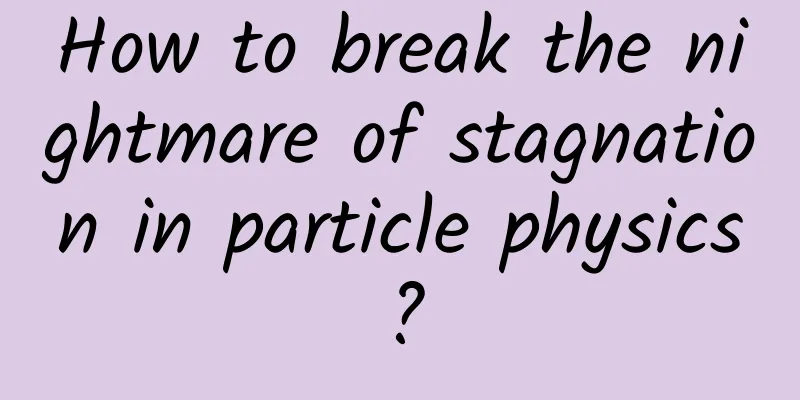How to break the nightmare of stagnation in particle physics?

|
Unless the Large Hadron Collider in Europe delivers some surprises, particle physics may be coming to an end. Compiled by Ye Lingyuan The ATLAS instrument, one of the four main detectors at the Large Hadron Collider, has been upgraded for a new round of collision experiments. Image credit: MAXIMILIEN BRICE/CERN Ten years ago, particle physicists thrilled the world. On July 4, 2012, the more than 6,000 researchers working at the Large Hadron Collider (LHC) at CERN, the world's largest particle accelerator, announced that they had found traces of the Higgs boson, an extremely high-mass, short-lived particle that holds the key to explaining how other elementary particles get their masses. The discovery confirmed a then-48-year-old theoretical prediction, completed a physics theory known as the Standard Model, and thrust physicists into the spotlight. The existence of the Higgs boson was first proposed by Peter Higgs in 1964. For a long time, physicists - including Higgs himself - were unclear about the physical significance of this hypothesis. But over time, people gradually realized the important role played by the Higgs boson in particle physics. It is the last missing piece of the Standard Model. This particle (or more precisely, the Higgs field that excites this particle) is the reason why all particles have mass. Mass is not an intrinsic endowment of particles as people originally thought; instead, it is the result of the interaction between particles and the Higgs field that permeates the entire universe. Physicists have believed this theory for decades, but it was not until 2012 that it was actually confirmed by experiments. The discovery of the Higgs boson was a monumental achievement in particle physics: it marked the end of a decades-long quest and the beginning of a new era of studying this extremely special particle. But the field has since fallen into a long hangover. Even before the 27-kilometer-long circular Large Hadron Collider began taking data in 2010, physicists worried that it might only produce the Higgs particle, leaving no clues to possible new physics beyond the Standard Model. Now, that nightmare scenario is becoming a reality. "It's a bit disappointing," said Barry Barish, a physicist at the California Institute of Technology. "I thought we were going to find supersymmetry," a mainstream physics theory that extends the Standard Model. But many physicists say it’s too early to despair. After three years of upgrades, the Large Hadron Collider is gearing up for the third of five planned rounds of experiments. It will produce billions of proton-proton collisions every second, and new particles may be born in them. The development of artificial intelligence has also brought new opportunities - ten years ago, most physicists would have scoffed at the idea of using neural networks to analyze data. But with the help of many younger researchers and industrial partners, a specialized neural network has been built to help physicists search through the vast amounts of data for phenomena worth further study. The Large Hadron Collider will run for another 16 years, and with further upgrades, it will collect 16 times the amount of data it has already collected. All this data may contain subtle traces of new particles and new physics. However, some researchers also believe that collision physics experiments have run out of luck. Juan Collar, a physicist at the University of Chicago, is looking for traces of dark matter in some small experiments: "If they still don't find anything, the whole field will die." John Ellis, a theoretical physicist at King's College London, said that the hope of making breakthroughs in this field has been worn away by the long and uncertain prospects of exploration, and the final failure will be as sudden and painful as pulling a tooth, not as silent as a tooth falling out naturally. Physicists have been wrestling with the Standard Model of particle physics since the 1970s. According to the model, ordinary matter consists of lightweight particles called up and down quarks—which bind together in groups of three to form protons and neutrons—as well as electrons and nearly massless particles called electron neutrinos. Two sets of heavier particles lurk in the vacuum of space, emerging only fleetingly in the shocks of particle collisions. All particles interact by exchanging other particles: photons carry the electromagnetic force, gluons carry the strong force that binds quarks together, and massive W and Z bosons carry the weak force. The Standard Model describes everything scientists have observed so far in particle colliders. However, it cannot be the final theory of nature. It cannot describe gravity, and it does not include mysterious, invisible dark matter, which may outnumber ordinary matter by about 6:1. Neutrinos are included in the Standard Model, but there is still no explanation for their extremely low masses; ordinary matter is obviously described by the Standard Model, but it is also unclear how it outcompeted antimatter and became dominant after the Big Bang. There are also many mysteries surrounding the Higgs boson itself that need to be solved. The LHC was supposed to break the impasse. In its ring-shaped structure, two protons circulating in opposite directions collide to produce heavy particles that are unavailable elsewhere, with energies more than seven times greater than any previous collider has ever achieved. A decade ago, many physicists envisioned that new phenomena would be quickly discovered at the LHC, including new particles that mediate interactions and even mini black holes. People thought they would be drowned in the supersymmetric particles produced, recalls Beate Heinemann, director of particle physics at the DESY laboratory in Germany. Physicists generally believed that finding the Higgs boson might take longer. But what was unexpected was that the Higgs boson was discovered so quickly, in just three years. This was partly because its mass was smaller than many physicists expected, only about 133 times that of a proton. If its mass exceeded the energy limit of the Large Hadron Collider, or its interaction with other particles was weak, we would have no hope of discovering it at all. Higgs himself once said that he never expected to find evidence of the existence of the Higgs boson in his lifetime, which was undoubtedly a milestone result in particle physics. But in the following 10 years, physicists have not discovered any other new particles. The barrenness of new phenomena challenges several principles that physicists hold dear. The principle of naturalness states that dimensionless ratios of physical constants in a theory should be of the same order as one. The low mass of the Higgs boson thus more or less guarantees that there are new, unknown particles in the energy range that the LHC can reach. According to the principles of quantum mechanics, any virtual particle wandering in the vacuum will interact with real particles and affect their properties—which is how the virtual Higgs boson gives them mass. The mass of the Higgs boson should be greatly increased by the other Standard Model particles in the vacuum, especially the top quark, but this is not the case. So theorists have concluded that at least one new particle with a similar mass and just the right physical properties—notably a different spin—exists in the vacuum to “naturally” cancel out the effects of the top quark. Supersymmetry provides a basis for the existence of such a particle: for each known Standard Model particle, it postulates the existence of a partner particle with a different spin and greater mass. These partners not only ensure that the mass of the Higgs particle is not too high, but also help explain how the Higgs field is generated. But over the past decade, only a few small discrepancies between experimental observations and the Standard Model’s predictions have been discovered, and these anomalies do not point to the existence of the hoped-for new particles. For example, in 2017, physicists using the LHCb detector (one of the four main particle detectors at the Large Hadron Collider) found that B mesons (a particle containing heavy bottom quarks) have a greater probability of decaying into electrons and positrons than into muons and antimuons, which should be equally likely according to the Standard Model. Similarly, experiments have shown that muons may be slightly more magnetic than the Standard Model predicts. The Higgs itself offers other avenues for exploration. In August 2020, teams of physicists working at the Large Hadron Collider’s ATLAS instrument and the Compact Muon Solenoid (CMS) detector announced that they had both spotted the Higgs decay into a muon and antimuon pair. If this rare decay has a different rate than theoretically predicted, the deviation could herald new particles hiding in the vacuum, suggests Marcela Carena, a theoretical physicist at Fermi National Accelerator Laboratory. Physicists will explore these phenomena during the next three-year run of experiments at the LHC. Those explorations, however, may not lead to dramatic “Eureka!” moments. “The experiments are now moving toward measuring subtle phenomena with very high precision,” Heinemann says. Still, Carena says, “I very much doubt that in 20 years I will say, ‘Oh boy, we learned nothing new after the Higgs discovery.’ ” If you think of the discovery of the Higgs boson as climbing a mountain, when Higgs first proposed his theory, we didn’t even know where the mountain was, or how high it might be—the Standard Model of particle physics wasn’t even complete. People only vaguely realized that somewhere on the top of a mountain there was a Higgs boson that could actually confirm the existence of the entire Standard Model structure. It wasn’t until the late 1990s that we had a sense of how high that mountain was; and it wasn’t until 2012 that we finally climbed the mountain. But now it’s different. We have to go down the other side of this mountain, across the barren plain. This plain stretches out, perhaps all the way to the Planck scale (the smallest scale of space in the universe). If our current predictions are correct, there must be other mountains somewhere on the plain, marking another peak in physics. Perhaps we can discover new particles, such as leptoquarks (which may be the key to explaining the anomalies of B mesons and muons mentioned above), or even supersymmetric particles or dark matter particles. Maybe we can solve more mysteries about the Higgs boson - is the Higgs itself an elementary particle or a composite particle? Can it interact with dark matter? If so, can we learn more about dark matter through it? Does the Higgs field give the Higgs its own mass through self-interaction? Many scientists are optimistic that we can solve these problems (even if it sounds a bit pie in the sky). But at least there is no clear indication of how far we have to cross the plain to see these new mountains - this is the difference between where we are now and in the past few decades. Others are less optimistic about the LHC experimenters’ chances. “They’re looking at a desert, and they don’t know how big it is,” says Marvin Marshak, a physicist at the University of Minnesota, Twin Cities. To solve these problems, we will probably need the ability to produce Higgs particles in large quantities, which the LHC cannot have now or even in 20 years. CERN is planning its next, higher-energy collider, the Future Circular Collider, as a future “Higgs factory.” But even optimists say that if the LHC doesn’t discover anything new, it will be harder to convince governments around the world to build the next, bigger, more expensive collider to keep the field going. These days, many physicists at the LHC are just excited to get back to work colliding protons. Over the past three years, scientists have upgraded detectors and redesigned the collider's low-energy accelerator section. Now, the LHC should have a more stable collision rate, effectively increasing the amount of data by as much as 50%, said Mike Lamont, director of accelerators and particle beams at CERN. For months, accelerator physicists have been slowly tweaking the particle beams produced by the LHC. When the beams are stable enough, they will turn on the detectors, resume data collection, and carry on with a new round of experiments, continuing their march across the dark plains. References [1] https://www.science.org/doi/10.1126/science.372.6538.113 [2] https://www.scientificamerican.com/article/how-the-higgs-boson-ruined-peter-higgss-life/ [3] https://www.scientificamerican.com/article/10-years-after-the-higgs-physicists-are-optimistic-for-more-discoveries/ [4] https://home.cern/news/press-release/physics/higgs-boson-ten-years-after-its-discovery Produced by: Science Popularization China Special Tips 1. Go to the "Featured Column" at the bottom of the menu of the "Fanpu" WeChat public account to read a series of popular science articles on different topics. 2. Fanpu provides a function to search articles by month. Follow the official account and reply with the four-digit year + month, such as "1903", to get the article index for March 2019, and so on. Copyright statement: Personal forwarding is welcome. Any form of media or organization is not allowed to reprint or excerpt without authorization. For reprint authorization, please contact the backstage of the "Fanpu" WeChat public account. |
<<: Here they come! What special features do these two Fengyun satellites have?
>>: Does purple sweet potato still contain anthocyanins after being cooked? Here comes the answer!
Recommend
IEA report: China’s roadmap for carbon neutrality in the energy sector
Over the past four decades, China’s remarkable ec...
3,000-word guide to Tik Tok operations!
With 400 million daily active users, Douyin has a...
How to do integrated marketing?
When companies are doing brand marketing, it is d...
What are the dangers of the "cold on the outside, hot on the inside" school of psychoanalysis that require sufficient attention?
In recent years, more and more people have discov...
If an iOS programmer is interviewed like this, the chance of getting an offer on the spot is 80%?
1. Overview Is an interview difficult or not? It ...
Linux tablet JingPad A1 starts crowdfunding, can it be comparable to iPad?
Recently, the company behind "JingOS" (...
How does “Duoduo Orchard” achieve gamification growth for Pinduoduo?
"Duoduo Orchard" is a casual social gam...
An investor's view of "Xiachufang": the story before the $30 million financing
Editor's note: [Xiachufang], this APP is not ...
How to advertise on Weibo? What are the methods of Weibo promotion?
Weibo is one of the most popular and active socia...
Sogou promotion account optimization tips!
Sogou promotion account optimization: PC and mobi...
New interpretation of ROI: input-output ratio
Why do many companies go bankrupt after their cap...
Taobao Art Training Camp for Beginners
The Taobao art training camp for beginners will a...
Really? The meat we eat in the future may not necessarily come from living animals!
□ Shan Shouqing The steamed buns invented by Zhug...
Xiaohongshu promotion strategy, big data + 3 major strategies!
With the development of information technology, t...
Half of the world's population is concerned about the health effects of the internet and smartphones
In the post-epidemic era, technology's domina...

![[Ten thousand words of heavy and in-depth] The strange current situation of the smart TV industry witnessed in the past ten years](/upload/images/67f0a96364895.webp)







